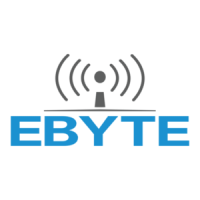Chengdu Ebyte Electronic Technology Co., Ltd. E03-W05A User Manual
Copyright ©2012–2020,Chengdu Ebyte Electronic Technology Co., Ltd
6.4.2 AT+CIOWRITE Set the GPIO level
Instruction format:
AT+CIOWRITE=<pin>,<level>
<pin>: pin label;
<level>: working mode;
1: High level
0: low level
6.4.3 AT+CIOREAD Read GPIO level
Instruction format:
<pin>: pin label;
6.4.5 Pin application example
①Use GPIO18 as output attribute and output low level
AT+CIOMODE=18,1
AT+CIOWRITE=18,0
②Use GPIO18 as an input attribute and read out the level
AT+CIOMODE=18,0
AT+CIOREAD=18
The module reply is as follows:

